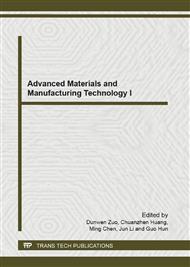p.7
p.11
p.15
p.20
p.24
p.28
p.32
p.36
p.40
Cutting Thickness of High Speed Ball-End Milling Hardened Steel
Abstract:
In order to solve the problem of machined surface damage and machining efficiency decline that caused by the decrease of effective cutting thickness in high speed ball-end milling hardened steel, using high speed cutting adiabatic shearing model, analyzed the adiabatic shearing deformation on hardened steel, and proposed the criterion of chip separating position. Analyzed the force in the transformation process from cutting to plowing, the influence of cutter deformation on cutting thickness was studied, and established the minimum cutting thickness model. Having done finite element analysis of cutter and experiment of high speed milling hardened steel, the validity of the minimum cutting thickness model was proved. The results show that cutting thickness changes from small to large, and then from large to small under the influence of cutting trajectory and tool edge radius. The deformation of cutter leads to the increase of the minimum cutting thickness, and further enhances chip thickness thinning effect. High feed can compensate cutting thickness thinning and the minimum cutting thickness model provides an effective way to restrain the damage of machined surface and cutter caused by cutter plowing.
Info:
Periodical:
Pages:
24-27
Citation:
Online since:
January 2012
Authors:
Price:
Сopyright:
© 2012 Trans Tech Publications Ltd. All Rights Reserved
Share:
Citation:


